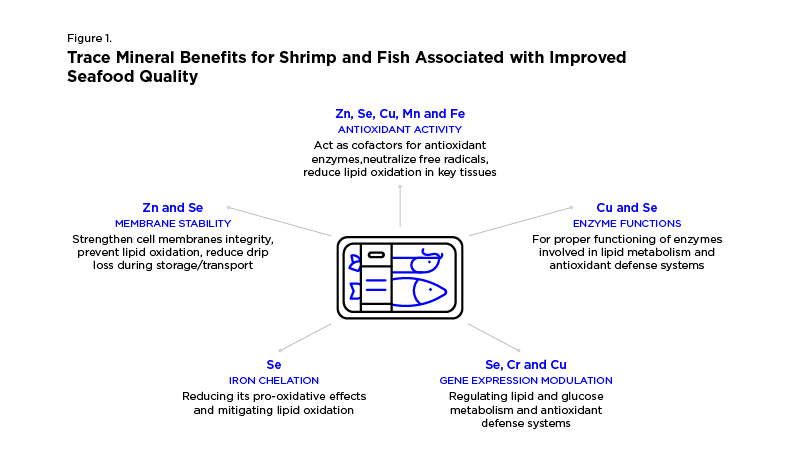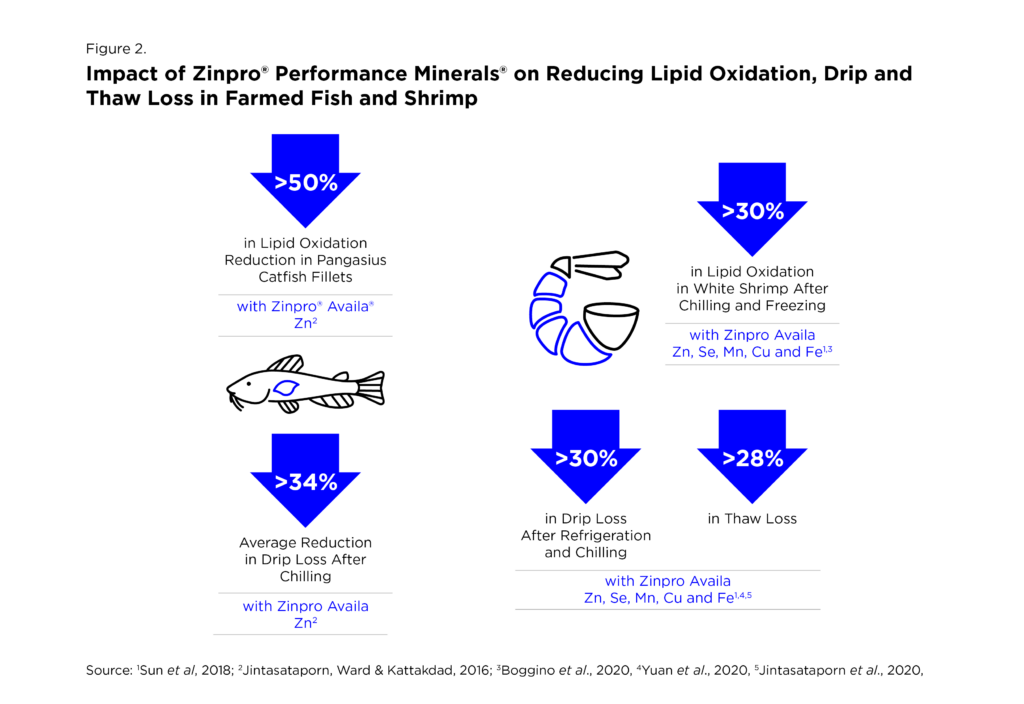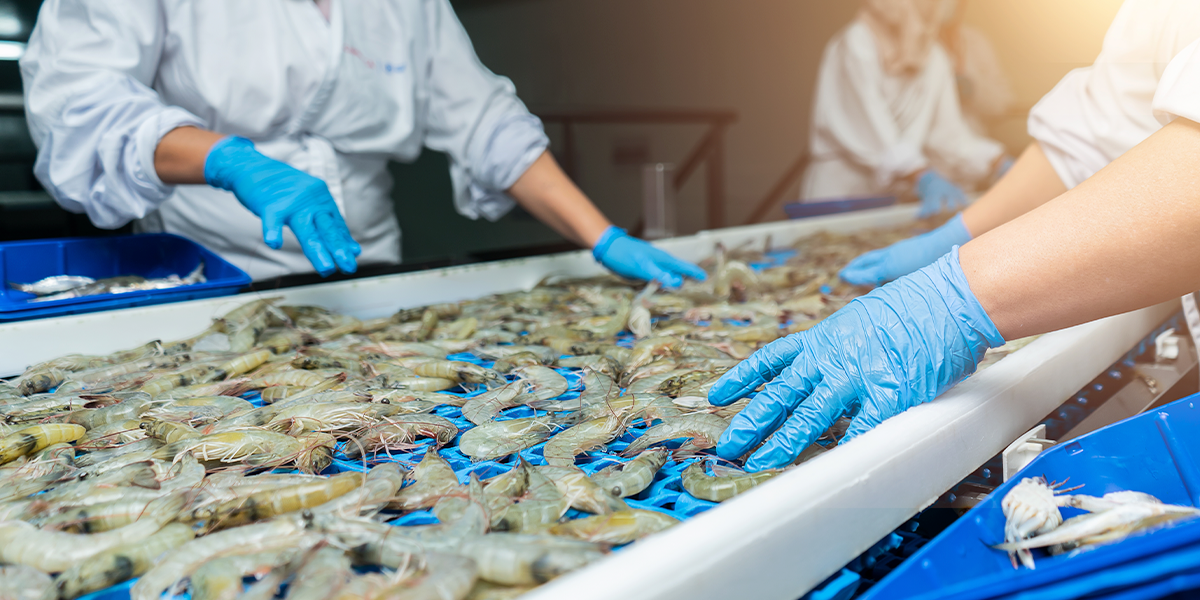Ensuring the freshness of farmed seafood is paramount to providing a positive and safe consumer experience. Preserving product quality along the cold chain during processing, distribution and storage is a key challenge encountered by the seafood industry globally.
Freezing and thawing are common techniques employed to maintain product quality. However, these techniques can lead to issues, such as drip loss and lipid oxidation, that can significantly impact both economic results and product sensorial attributes.
This article will explore the importance of mitigating these issues and will explain how the right trace mineral nutrition can support you to protect quality from farm to table.
Lipid Oxidation Puts Seafood Quality at Risk
When seafood lipids undergo oxidation, it leads to the development of off-flavors and rancidity, making fish and shrimp less appealing to consumers. Moreover, it can affect meat proteins resulting in a loss of firmness and texture. Lipid oxidation also contributes to the reduction of the nutritional value, particularly essential fatty acids like omega-3, which are beneficial for human health. In salmon and shrimp, it can also lead to the degradation of important pigments like astaxanthin, reducing the so-desired vibrant coloration of fresh fillets and cooked tails.
In addition to unpleasant odors and taste, oxidized products can trigger health disturbances in consumers, depending on the degree of oxidation and accumulation of potentially harmful compounds like hydroperoxides and aldehydes.
Why Drip and Thaw Loss Matter to Your Bottom Line
Throughout post harvesting phases, several factors can contribute to the loss of water and weight, including handling time and temperature management, freezing and cooking methods, type of packaging and thawing techniques.
Drip loss refers to the loss of moisture during processing, transportation and storage, while thaw loss occurs when frozen seafood is thawed. Both type of losses can result in several negative impacts:
- Decreased product weight and yield resulting in economic losses to farmers, processors, distributors and retailers
- Poor texture generates a mushy mouthfeel or watery texture
- Impaired sensory attributes lead to reduced freshness, flavor and overall eating experience
- Loss of water-soluble nutrients like vitamins, minerals and peptides and flavor compounds
- Increased bacterial and spoilage microorganisms’ growth can reduce shelf life and increases safety risks to consumers
Preserving Quality Through Proven Trace Mineral Nutrition
It is well-known that temperature and time management, hygiene and sanitation, packaging and storage conditions are top priorities to assure seafood quality and conservation during downstream processes. However, other aspects like animals’ rearing practices and aquaculture nutrition shouldn’t be overlooked during upstream stages, as they can influence the subsequent stages – positively or negatively.
Trace minerals play important roles in modulating fish and shrimp immunity, antioxidant capacity and quality after harvest, with scientifically proven mechanisms, as shown in Figure1.

Zinpro® acknowledges that high quality standards and operational efficiency are top priority goals for the aquaculture industry and actively collaborates with partners to develop solutions to improve quality traits, processing yield and profitability. Sharing this mission, we dedicate efforts to research and advance trace mineral nutrition to support preventing lipid oxidation, drip and thaw loss, as shown in Figure 2.
Taking a holistic approach to integrate nutritional strategy at farm level with the quality of seafood products at consumers’ hands can yield significant benefits throughout the seafood value chain. Our research has shown:
- Zinpro® Performance Minerals® have a proven track record of enhancing zootechnical performance leading to profitability gains over 15%, while positively influencing product quality
The loss of value during post-harvest stages can exceed 5%, depending on processing phases and product types. However, the incorporation of Zinpro Performance Minerals:
- Reduced drip and thaw loss by an average of 30% and 25% respectively
- Curbed lipid oxidation by an average of 40%
- Positively impacted shrimp color and sensory aspects linked to consumer acceptance

Preserving Seafood Quality, Reaching Premium Markets
As product quality and competition for premium markets gain momentum, Zinpro Performance Minerals emerge as a catalyst for achieving your goals. Our expert team harnesses advanced nutrition to enhance health, growth performance and feed efficiency, improving economic margins and reducing the farm-level feed footprint. By bolstering yields and improving product quality, superior minerals can help the industry to sustain the high-quality standards consumers expect while optimizing return on investment.
Let’s Partner: Elevate Seafood Quality Through Proven Nutrition
By improving antioxidant functions, membrane integrity and mineral composition with Zinpro Performance Minerals, we can reduce drip loss, lipid oxidation and yield loss that impact direct on your profitability and product quality. To learn how you can include Zinpro Performance Minerals in your fish and shrimp diets, contact your Zinpro representative today.

